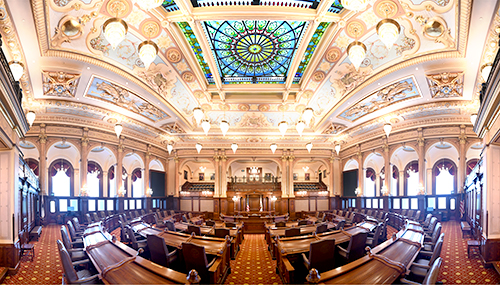Gov. Pritzker outlined a five-phase plan for reopening the state's economy dubbed Restore Illinois and detailed the regions and metrics by which it would be acted upon.
The governor spoke frankly with Illinoisans, saying all indicators point toward a long path toward anything resembling pre-COVID normalcy.
"Here's the truth, and I don't like it any more than you do: Until we have a vaccine or new cases fail to materialize, the option of returning to normalcy doesn't exist," Pritzker said. "That means we have to figure out how to live with COVID-19 until it can be vanquished."
The Restore Illinois plan would feature region-based reopenings, with the state divided by established IDPH regions: The Northeast, North Central, Central and Southern regions.
Some details on the five phases of reopening:
- Where we were prior to April 30.
- Where the entire state has been since the new May 1 order, with selective businesses open.
- Healthcare regions that meet certain thresholds move to Phase 3, with face coverings as the norm, non-essential manufacturing and non-essential businesses open, and tele-work highly encouraged. Other businesses such as barber shops, health and fitness one-on-one personal training and state parks can open. Limited child care and summer programs can operate within DPH guidelines. Gatherings of 10 people or fewer can take place.
- Restaurants, bars, spas, cinemas, and health clubs can open with new capacity limits and within DPH guidelines. Schools, summer and fall programs can open with safety guidance, and all outdoor recreation would be allowed. Public gatherings of 50 or fewer people would be allowed depending on what the science tells officials.
- Phase Five, a return to all normal pre-COVID operations, can only be achieved with a vaccine, an effective treatment, or a widespread decline in new cases.
Metrics for determining when these regions can move to these new phases:
- The region must be at or under 20% test positivity and increasing by no more than 10% over a 14 day period.
- The region must either not have had overall increase or must have maintained overall stability in hospital admissions in 28 days.
- The region must be maintaining availability of hospital surge threshold of 14% of all hospital metrics (beds, ICU, vents).
Pritzker said the state lacks the ability to police 12.7 million Illinoisans but is working with local law enforcement about the practicalities of enforcing these precautions.
IDPH Director Dr. Ngozi Ezike reported 2,122 new confirmed COVID-19 cases, bringing the state's total to 65,962 cases, and 176 additional deaths, bringing the state's total death toll to 2,838.
She also stressed that while a feeling of cabin fever after several weeks of the Stay at Home Order is understandable, the grim reality is that Illinoisans are dying at an unprecedented rate, and social distancing must continue lest the situation worsen.
"If this was a traditional war with soldiers outside our doors in the streets and people risking their lives being aside in their homes, nobody would think about going to work or getting their dog groomed," Ezike said. "This enemy is invisible, and maybe as a result of that, we've underestimated the power and destruction of this enemy, despite the fact more than 2,500 Illinoisans have lost their lives in just two months."
The governor said regional data would be provided online so anyone can track results.
Dr. Ezike was asked about a Tribune story regarding a mutated, more contagious version of the virus.
She said that medical personnel have seen two strains, one of which is more aggressive and more lethal.













 © 2025 Illinois Senate Democratic Caucus
© 2025 Illinois Senate Democratic Caucus